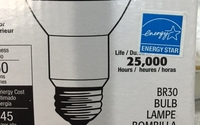Commentary
Lightbulb Lessons in The Internet of Things: Promise Vs. Reality
- by Chuck Martin , Staff Writer, November 30, 2015
 A lightbulb in my house burned out over the weekend.
A lightbulb in my house burned out over the weekend.
That would not be any big deal if these were normal, traditional lights, which they are not.
They are some of the latest LED lighting technology, with the stated lifetime to be in the thousands of hours. And yet they failed, not lasting even into the hundreds of hours.
This reminded me of the distance between something being created and something working at scale, one of the key issues around The Internet of Things.
It’s all about the promise vs. the reality.
For example, some of the new LED lights being sold in places like Home Depot, Lowe’s and any number of department stores nationwide promise unheard of working hours ahead.
One box with a 65-watt Philips LED states: “Lasts for 22+ years.” Another, from 3M, states: “Lasts 22 years/25,000 hours.” You get the drift.
In the case of my lights, which have not been on even 50% of the time, they burned out in a little over a year.
The promise on the box was for 25,000 hours. That’s roughly three years, if left on 24/7. It wasn’t even close. And this is the third of those lights from Sylvania to fail prematurely. And these are not small brands.
But the point is not about the lights, it’s about what marketing is teaching consumers to expect and then the companies they represent not delivering on that expectation.
And that’s where we are in The Internet of Things.
At CES International earlier this year and the year before we saw countless IoT innovations. Some of them were clever, but many had no hope of ever scaling to the masses.
Before figuring out the marketing and messaging approach to consumers, brands and agencies may want to carefully measure the distance between the promise and what can actually be delivered.
Of course, there are many connected things that work and work well. For example, the Belkin WeMo switch does what is promised: it lets something be turned on and off remotely via mobile app. Simple, but effective. And it doesn’t burn out.
And fitness trackers from Fitbit and Jawbone work as advertised, and in some cases, even over-deliver on the promise.
My lightbulb burnout situation also begs the question that if commonly sold lightbulbs can’t work for an extended period of time, how can we expect that IoT innovations such as connected lighting installed in buildings will fare any better?
This is likely one of the reasons brands are treading quietly around The Internet of Things. For example, before a retailer tells its customers that it has beacons in its stores to add value to the shopping experience, the retailer likely is looking to make sure the beacons consistently work over a period of time and that actual value can be delivered to shoppers.
Connected objects are going to be virtually everywhere consumers go.
After the objects connect to each other, the information and messaging that can ride along that connected path will be targeted to reach consumers.
This is not about lightbulbs.




Insightful thoughts about the pitfalls of going straight to IoT thinking without considering the individual impact. I'd argue that you're pointing out the opposite of scale, and that's personalization.
At scale, LED lighting will save thousands of kilowatts of energy and reduce overall power demand. However, for you, these lights did not work. You don't care about the promise of scale if your investment burns out way before its time.
I see this all the time not just in IoT innovations, but in media promises to deliver more accurate targeting, better, more efficient, and cheaper delivery. However, if the audience and message don't interact in a relevant way, the scale fails. They didn't think about the personal level.
Good points, Jonathan. As to the issue of scale, if many people have the same negative personal experience, the given product/approach is likely to fail, as in not achieving succesful scale.